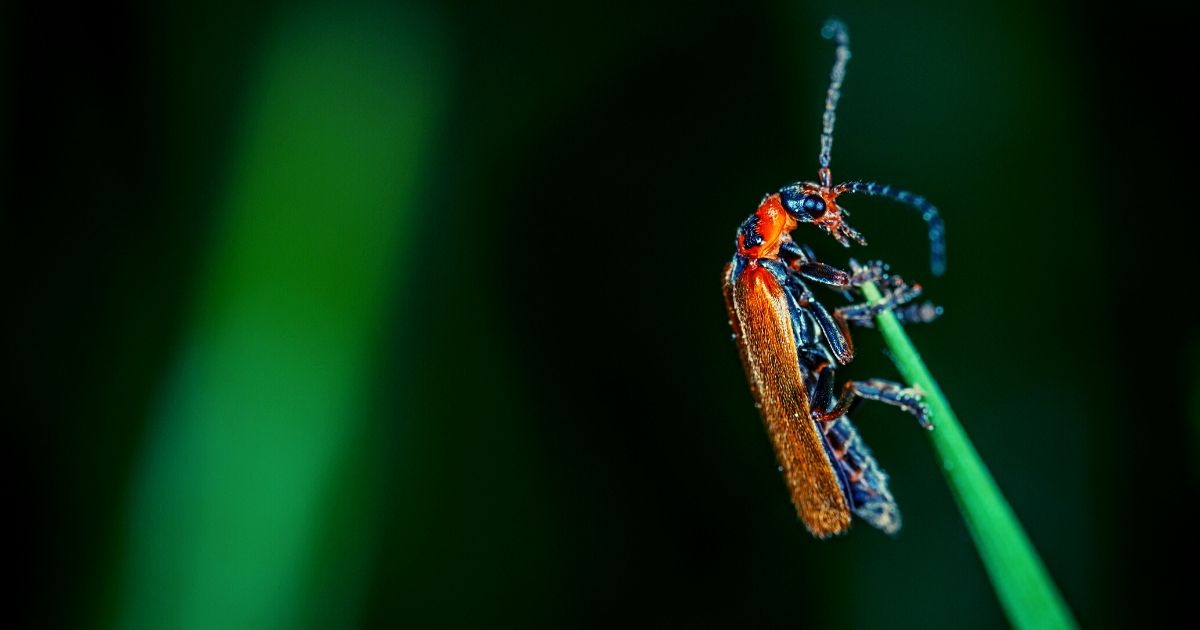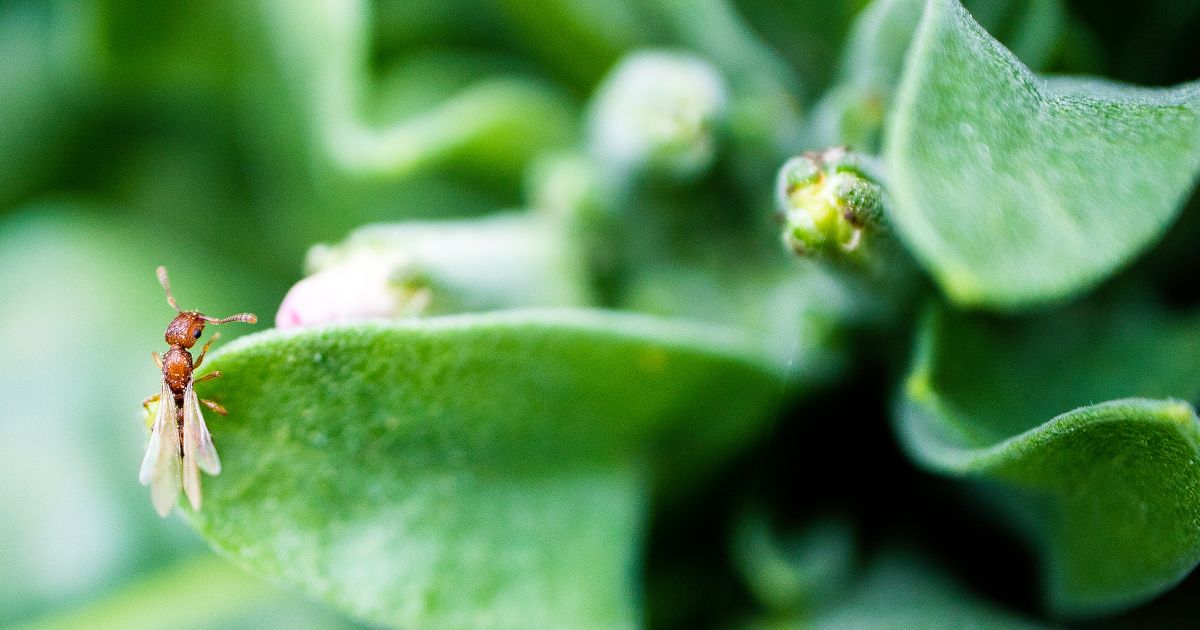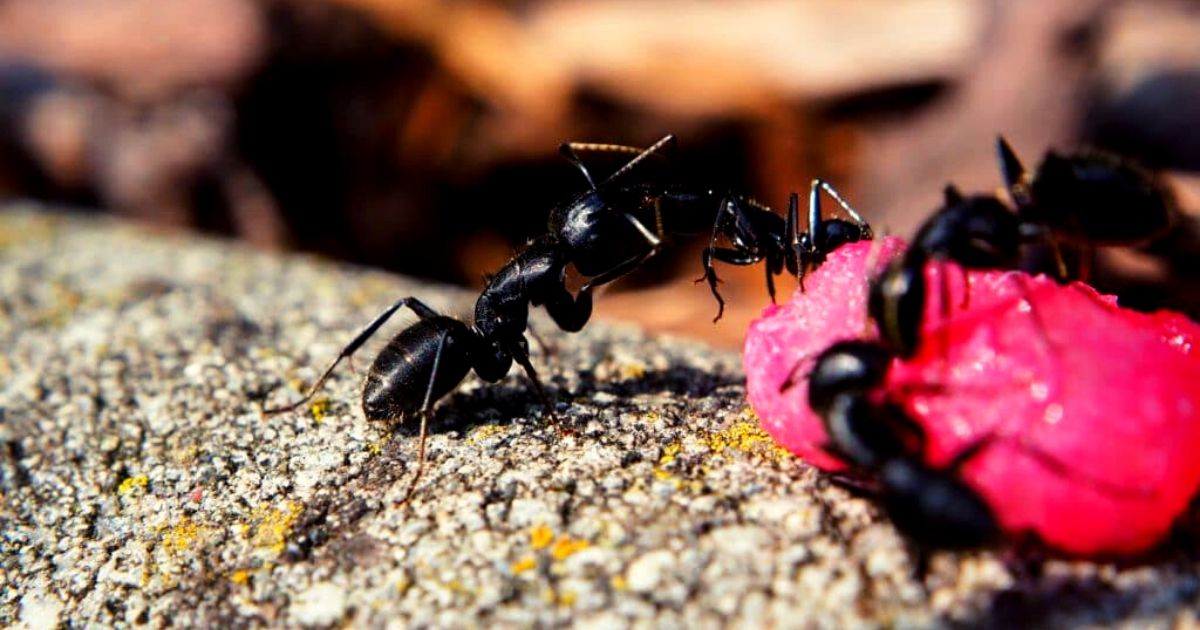The Ultimate Guide to Ant Prevention and Treatment in Singapore
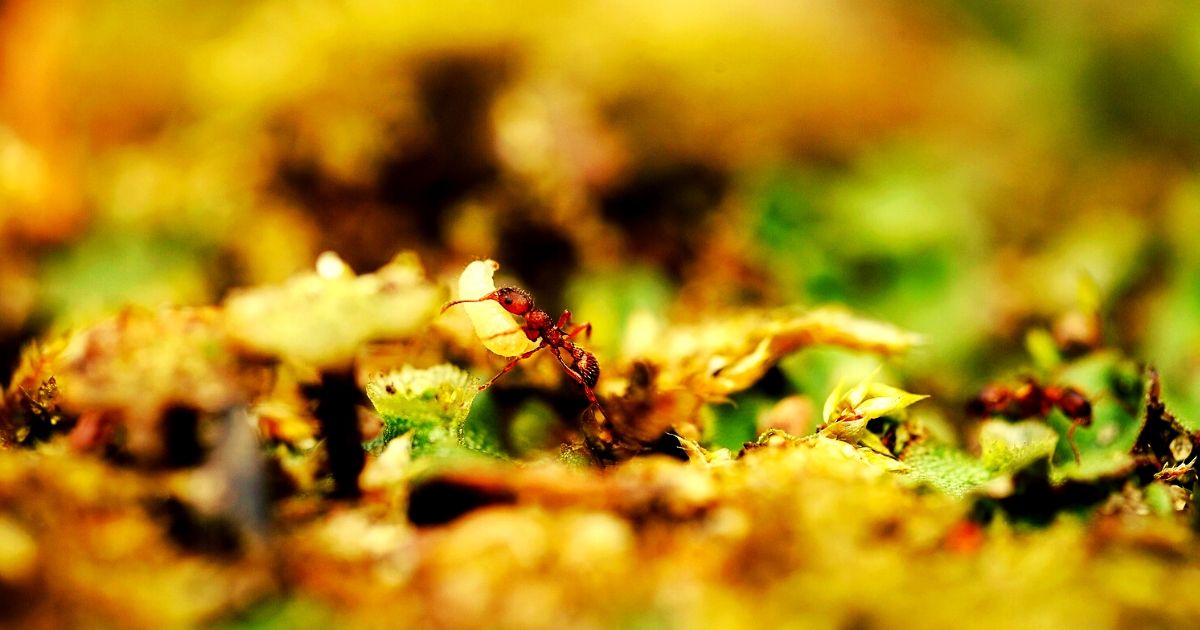
Have you ever walked into the kitchen only to find ants feasting on the cakes that you forgot to place in the fridge? Or did you find the carcasses of ants in the drinks that you were just about to finish? These scenarios are familiar to most of us. The presence of ants may be a sign of a larger ant infestation. Ant infestations are relatively harmless in most cases. Severe ant infestations may cause problems and badly affect the quality of life.
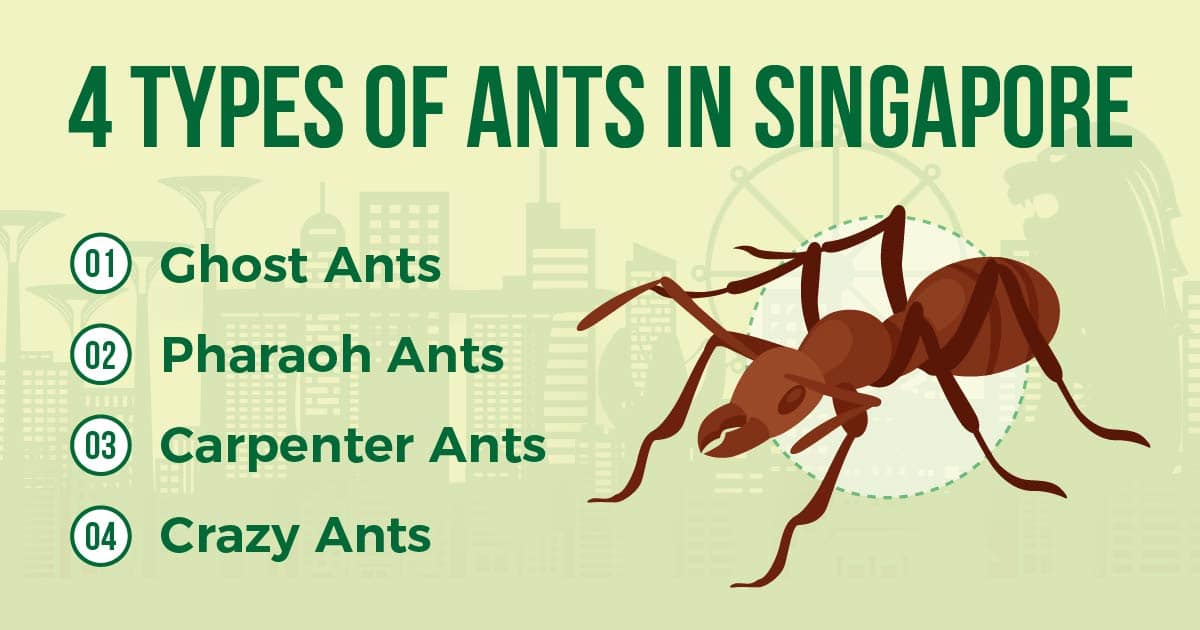
Types of Ants in Singapore
Some of the most commonly found ants in Singapore are:
These ants may enter homes searching for food and shelter. Buildings appeal to ants since they offer protection from weather and predators.
Ghost ants
Ghost ants – also known as sugar ants – love moist environments. They are usually active in kitchens. For example, inside cabinets, under the sink or behind the fridge.
Characteristics of ghost ants:
- 1.3 to 1.5mm big
- Dark heads
- Translucent bodies
- They love sweet and sugar-rich foods as they contain carbs to feed the colonies
Pharaoh ants
Pharaoh ants are a real nuisance. They can be hard to handle. Pharaoh ants are relatively resistant to pesticides. If you spray pesticides, their colony will break and move into new territories. This makes it challenging to eliminate pharaoh ants. Also, pharaoh ants tend to bite when threatened.
The characteristics of pharaoh ants include:
- 2mm big
- Distinctive golden or brown colour
- They enjoy oily and protein-rich foods
- Queens can live anywhere from 4 to 12 years
Pro tip: It is important to identify the type of ant infestation to choose the right method to treat ants.
Carpenter ants
Carpenter ants, as their name implies, live in wooden structures. Though they do not eat wood, they will create an area for their colony with their mouths. Hence, carpenter ants are sometimes thought to be termites.
Characteristics of carpenter ants:
- 15 to 17mm big
- Black and reddish-brown
- They love eating honeydew and dead insects
- Often found in moist-rich areas such as bathrooms
Crazy ants
Last on this list is the crazy ants. Their name relates to their defence techniques. Once disturbed, crazy ants will swiftly move in all directions. This makes it challenging to eliminate them.
Characteristics of crazy ants:
- 2 to 3mm big
- Long legs
- Black or dark red colour
- Antennae
- They love sugary foods (hence they will occupy similar places as ghost ants)
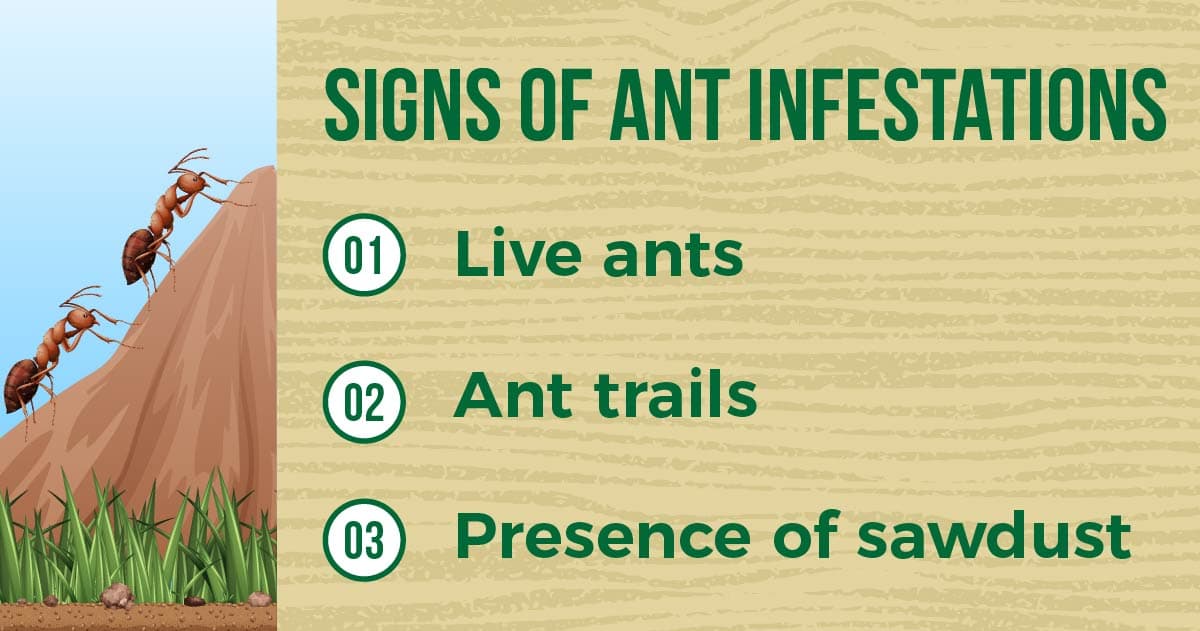
Signs of an Ant Infestation
Ants from the external surroundings may enter your house occasionally as they forage for food. Thus, you should not have to worry when you see one or two ants in the house. However, there are some tell-tale signs indicating that you might be having an ant infestation around your home.
1. Live ants
One of the most apparent signs indicating an ant infestation is the sightings of a large number of live ants. They are usually present around food and food preparation areas as they forage for food.
2. Ant trails
Ants leave a trail of pheromone as they forage. This allows other members of the colony can follow. An ant trail forms as ants travel on the same path with the pheromone. Following the ant trail may lead you to their nest.
3. Presence of sawdust
The presence of sawdust may indicate the presence of carpenter ants. Carpenter ants do not consume the wood that they infest. Instead, they expel the wood from the tunnels they make, leaving behind piles or trails of sawdust.
Want to find out more about ant control in Singapore?

Life Cycle and Biology
Similar to insects like mosquitoes and butterflies, ants undergo a complete metamorphosis. Their life stages consist of:
- Eggs
- Larvae
- Pupae
- Adulthood
Ants are also social insects that practice a caste system. Thus, the normal function of a colony is maintained through the division of labour by different castes. An ant colony consists of a queen, alates, workers, pupae, larvae and eggs.
Reproducing
The queen is the largest individual in a colony. Her primary function is to reproduce and grow the colony. The queen only mates once but continues to reproduce throughout its entire lifespan.
A male’s sole function is to mate, and it dies after its task is accomplished.
The alates are the winged individuals that fly off to form new colonies. New colonies can also be created through a process known as budding, whereby the queen ant leaves the nest to start a new colony in another location.
Workers
The worker is the most common caste which encompasses the ants that we see in the surrounding. The tasks of the workers include:
- Foraging for food
- Feeding the workers
- Guarding and tending to the nest
Some species of ants have workers that are dimorphic. This means that the workers are further classified into:
- Major workers: larger
- Minor workers: smaller
The larvae are fragile and legless, so they need nursing from the workers.
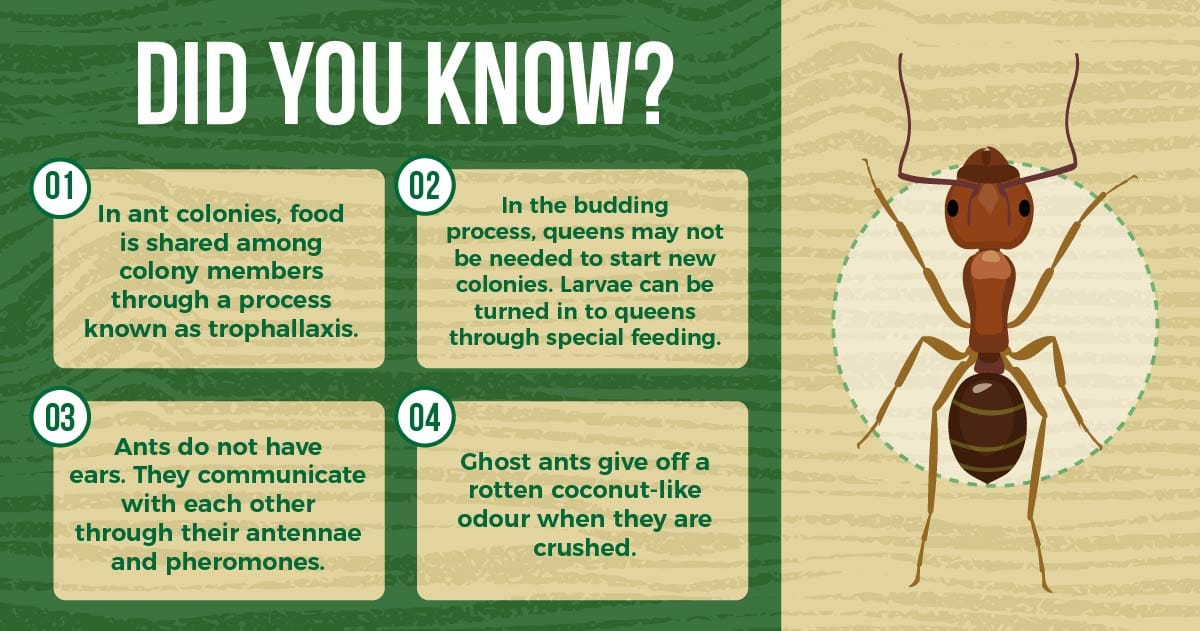
Hazards
Ants are not important vectors of diseases, so they pose little medical concerns. However, the presence of ants still poses risks to homeowners.
1. Nuisance
The sight of ants around your house may be unpleasant. Ants are an eyesore to people who hate insects. They may also climb onto your body unnoticed and cause irritation.
2. Structural damage
Severe infestation by carpenter ants may hollow out wooden structures, causing the structures to weaken. In turn, this increases the risk of collapsing.
3. Occurrence of other pests
The presence of ants may cause other entomophagous pests such as spiders and geckos to thrive. Ants serve as a food source for these pests. Thus, the increase in the food supply would undoubtedly benefit their predators.
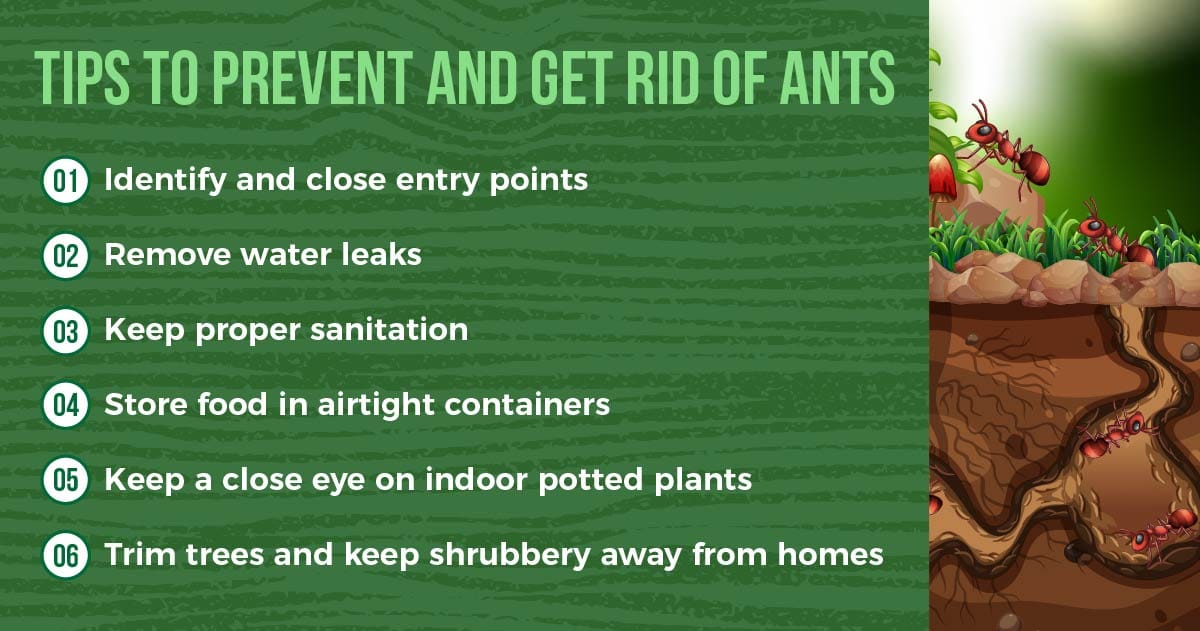
Tips to Prevent and Get Rid of Ants
6 ways to prevent and get rid of ants in Singapore:
1. Identify and close entry points
How do ants find their way into your home? Understanding this will allow you to block ants from entering. Usually, ants enter through cracks in the walls, floors, ceilings, windows and pipelines. Even the tiniest of spaces is enough for ants to enter. Prevention is key, thus your first task is to find and seal all possible entry points.
2. Remove water leaks
Water is one of the sources that ants thrive on. Ants also nest in moist areas. Therefore, water leaks are an attraction for ants. If you see ants in your house, there may well be a water leak somewhere. We recommended you to inspect your home for leaking pipes.
3. Keep proper sanitation
All creatures need food to survive. It is important to keep your home clean at all times. By doing so, you will not attract ants. Make it a habit to clean your home thoroughly, including counters, tables, floors and especially all parts of the kitchen. Regularly throwing out the garbage also helps a lot in preventing ants.
4. Store food in airtight containers
Food storages are great attractions for ants. Their tiny bodies can usually squeeze through any narrow gaps in search for crumbs and other food rests. Thus, we recommend using airtight storage containers for your food. Also, consider storing fresh items such as fruit in the fridge.
5. Take good care of indoor potted plants
Even if you follow the first steps rigidly, there is still a chance of an ant infestation. Our next tip addresses plants. As plants need water, so do ants. Thus ants are often attracted to indoor potted plants. They may even build a colony inside a pot. Hence, carefully check around plant pots for signs of ants.
6. Trim trees and keep shrubbery away from home’s exteriors
Taking care of your garden is our final tip. Why take care of the outdoors? Because this where the ants are coming from. If you want to get rid of ants, start in the outdoors. Examples include trimming tree branches and keeping things neat and tidy.

Pest Problem? Let Us Help.
We offer fast and effective precision treatments to eliminate pests while ensuring a safe environment for your home or business.
DIY Methods to Prevent and Get Rid of Ants
Ants are sensitive creatures, not only able to sense sweet stuff but also capable to detect the smells they hate. Home remedies such as cinnamon, lemon juice and peppermint can act as natural ant deterrents to prevent their access to our homes. The home remedies can be sprayed at doorways, windowsills, and potential entry points to help in deterring them away.
Professional Ant Treatment
Residual spraying is the most common method used to treat ants. However, it does not always work for all species. It is usually used when we can detect and access the ant nest. Or, the ants will not be shaken by the insecticide, which can worsen the infestation. Residual chemical can also be sprayed at the entrance or potential entry point if we want to prevent garden species from coming into our premise.
Some species of ants are hard to handle. They are eliminated but then re-appear. Some ants cannot be eradicated with insecticide spray. Thus it is important to identify the type of ant infestation.
The baiting method is preferable, especially when dealing with ants indoors. The bait that we use is a mix of an insecticide and some food attractants. It is non-repellent and slow-acting, which does not kill ants quickly. The bait will be placed at multiple locations where their activity is identified. The slow-acting nature of the bait works when the workers carry the bait back to their nest and feed it to the brood, nest mates and queen. Subsequently, the nest is eliminated.
Notice any ants? Remain calm and contact a professional to prevent further spread of ants. Our staff are licensed and certified with the National Environment Agency (NEA). Our service technicians understand the habits of different types of ants and will provide the correct type of treatment.



